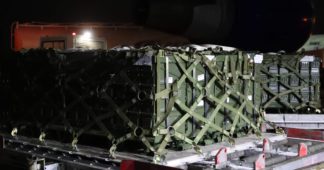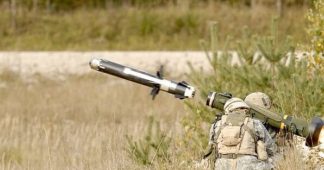By Andre Damon
Mar 3, 2022
In a global weapons-running program without precedent in post-World War II history, more than 20 countries, including members of NATO and the European Union, are funneling weapons, including anti-aircraft missiles, to Ukraine for use in NATO’s proxy war with Russia.
“Thousands of anti-tank weapons, hundreds of air-defense missiles and thousands of small arms and ammunition stocks are being sent to Ukraine,” bragged NATO in an official dispatch.
The United States has been joined by Germany, France, Poland and the UK, as well as the majority of the European Union in sending offensive weapons to Ukraine.
“Belgium, Canada, the Czech Republic, Estonia, France, Germany, Greece, Latvia, Lithuania, the Netherlands, Poland, Portugal, Romania, Slovakia, Slovenia, the United Kingdom and the United States have already sent or are approving significant deliveries of military equipment to Ukraine,” NATO said.
US officials are openly comparing the present operation to the “rat lines” used to arm Islamic fundamentalist terrorists in the Middle East in recent decades.
“On NATO territory, we should be the Pakistan,” Douglas Lute, a former lieutenant-general and American ambassador to NATO, told the New York Times, “supplying the Ukrainians as Pakistan supplied the Taliban in Afghanistan, stockpiling matériel in Poland and organizing supply lines.”
The shock troops of this latest US-led proxy war will not be, as in Afghanistan, Islamic fundamentalist fighters, but the neo-Nazi forces which played a key role in Ukraine’s 2014 coup.
“We have been given so much weaponry… because we perform the tasks set forth by the West, because we like to fight, and we like to kill,” Yevhen Karas, leader of the neo-Nazi terrorist organization C-14, said in early February, before the war began.
On Wednesday, the New York Times reported that the European Union had opened a hub in Poland to run weapons into Ukraine, citing a French EU official.
Poland has pledged, in the words of the New York Times, to “provide tens of thousands of shells and artillery ammunition, anti-aircraft missiles, light mortars, reconnaissance drones and other reconnaissance weapons.”
An article by Steven Erlanger in the New York Times stressed the scale of the weapons transfers, warning, in an understatement, that “Moscow may see it as a dangerous intervention.”
The Dutch are sending rocket launchers for air defense. The Estonians are sending Javelin antitank missiles. The Poles and the Latvians are sending Stinger surface-to-air missiles. The Czechs are sending machine guns, sniper rifles, pistols and ammunition. Even formerly neutral countries like Sweden and Finland are sending weapons. And Germany, long allergic to sending weapons into conflict zones, is sending Stingers as well as other shoulder-launched rockets. …
Sweden, not a member of NATO, announced that it would send Ukraine 5,000 antitank weapons, 5,000 helmets, 5,000 items of body armor and 135,000 field rations, plus about $52 million for the Ukrainian military. Finland, similarly, has said it will deliver 2,500 assault rifles and 150,000 rounds of ammunition for them, 1,500 antitank weapons and 70,000 combat rations.
Even as they funnel such vast quantities of weapons into Ukraine, NATO countries are massively increasing their commitment of forces on Russia’s borders. The Times reports that NATO is moving as many as 22,000 more troops into countries bordering Russia.
The United States has deployed 15,000 additional troops to Europe and provided an additional 12,000 troops to NATO’s rapid response force. The US has also deployed additional fighter jets and attack helicopters to Eastern Europe.
The US forces are joined by France and Germany, which are deploying fighter jets, tanks and troops to Poland and Romania. The UK, meanwhile, has sent hundreds of troops and tanks to Estonia and Poland. Canada has sent over 1,200 soldiers to Latvia, while Italy has put 3,400 troops on standby.
The massive troop concentrations on Russia’s borders are leading to threats of conflict between Russia and NATO.
“Risks of a clash between Russian and NATO forces do exist, and there are no guarantees incidents will not take place,” the state-run Russian news agency TASS paraphrased Deputy Foreign Minister Alexander Grushko on Wednesday.
“Risks do emerge. Of course, we are worried about weapons supplies. All this is very dangerous,” Grushko said. “There are no guarantees some incidents will not occur.”
The New York Times struck up the same tone, writing:
“In fact, even if no NATO soldier ever crosses into Ukraine, and even if convoys of matériel are driven to the border by non-uniformed personnel or contractors in plain trucks, the European arms supplies are likely to be seen in Moscow as a not-so-disguised intervention by NATO.
… World wars have started over smaller conflicts, and the proximity of the war to NATO allies carries the danger that it could draw in other parties in unexpected ways
… However proud Brussels is of its effort, it is a strategy that risks encouraging a wider war and possible retaliation from Mr. Putin. The rush of lethal military aid into Ukraine from Poland, a member of NATO, aims, after all, to kill Russian soldiers.”
These warnings came amidst a mounting death toll as the war entered its eighth day. Russia has admitted that 498 of its soldiers have died so far, while Pentagon officials estimate that 2,000 Russian soldiers have died, and Ukraine claims to have killed over 5,000.
The United Nations, meanwhile, reports that 227 civilians have been killed between February 24 and March, noting that this figure is likely an underestimation. Over the past week, 1 million people out of a total population of 44 million have fled the war, according to the UN.
The US and EU have also massively intensified their economic warfare against Russia, with the European Union announcing a ban on the supply of Euro banknotes to Russia on Wednesday.
In response, Moody’s downgraded Russia’s debt to junk status, writing, “The scope and severity of the sanctions announced to date have gone beyond Moody’s initial expectations and will have material credit implications.”
In a sign of just how high tensions have become, the United States has delayed the test launch of an intercontinental ballistic missile.
“In an effort to demonstrate that we have no intention of engaging in any actions that can be misunderstood or misconstrued, the secretary of defense has directed that our Minuteman-III intercontinental ballistic missile test launch scheduled for this week to be postponed,” Pentagon Press Secretary John Kirby said in a briefing
⚡️Correction: Ukrainian special forces will no longer capture Russian artillerymen.
The command of Ukraine’s Special Operations Forces has warned that it will not spare Russian artillerymen in response to their “brutal shelling” of civilians and cities.
— The Kyiv Independent (@KyivIndependent) March 2, 2022
The Ukrainian regime, meanwhile, has been visibly emboldened by the open backing and weapons deliveries from the imperialist powers. The twitter account of the Kyiv Independent reported Wednesday, “Ukrainian special forces will no longer capture Russian artillerymen. The command of Ukraine’s Special Operations Forces has warned that it will not spare Russian artillerymen in response to their ‘brutal shelling’ of civilians and cities. If implemented, such a policy would constitute a war crime and open violation of the Geneva Convention for the Humane Treatment of Prisoners of War.”
Πηγή: www.wsws.org
We remind our readers that publication of articles on our site does not mean that we agree with what is written. Our policy is to publish anything which we consider of interest, so as to assist our readers in forming their opinions. Sometimes we even publish articles with which we totally disagree, since we believe it is important for our readers to be informed on as wide a spectrum of views as possible.












